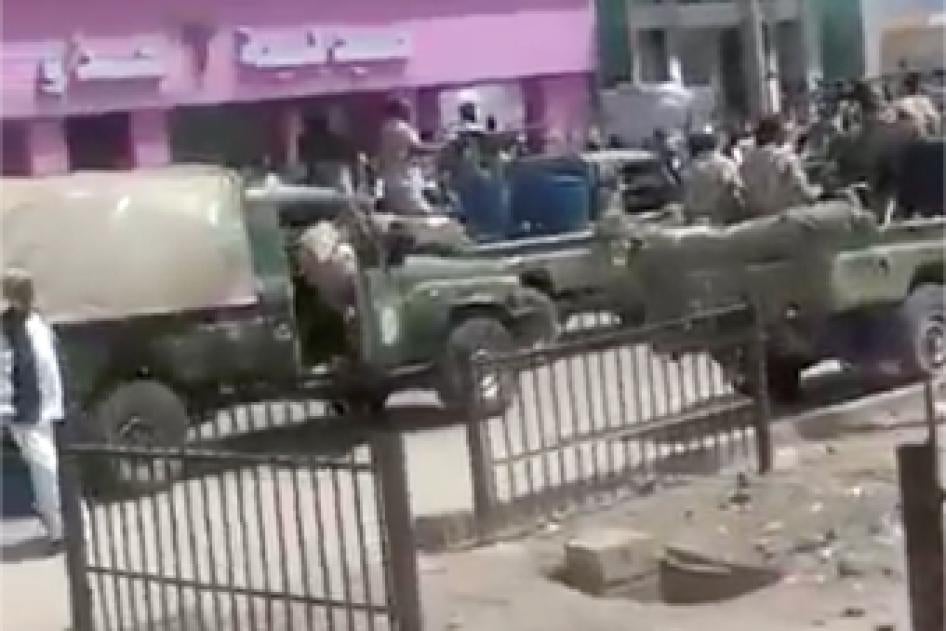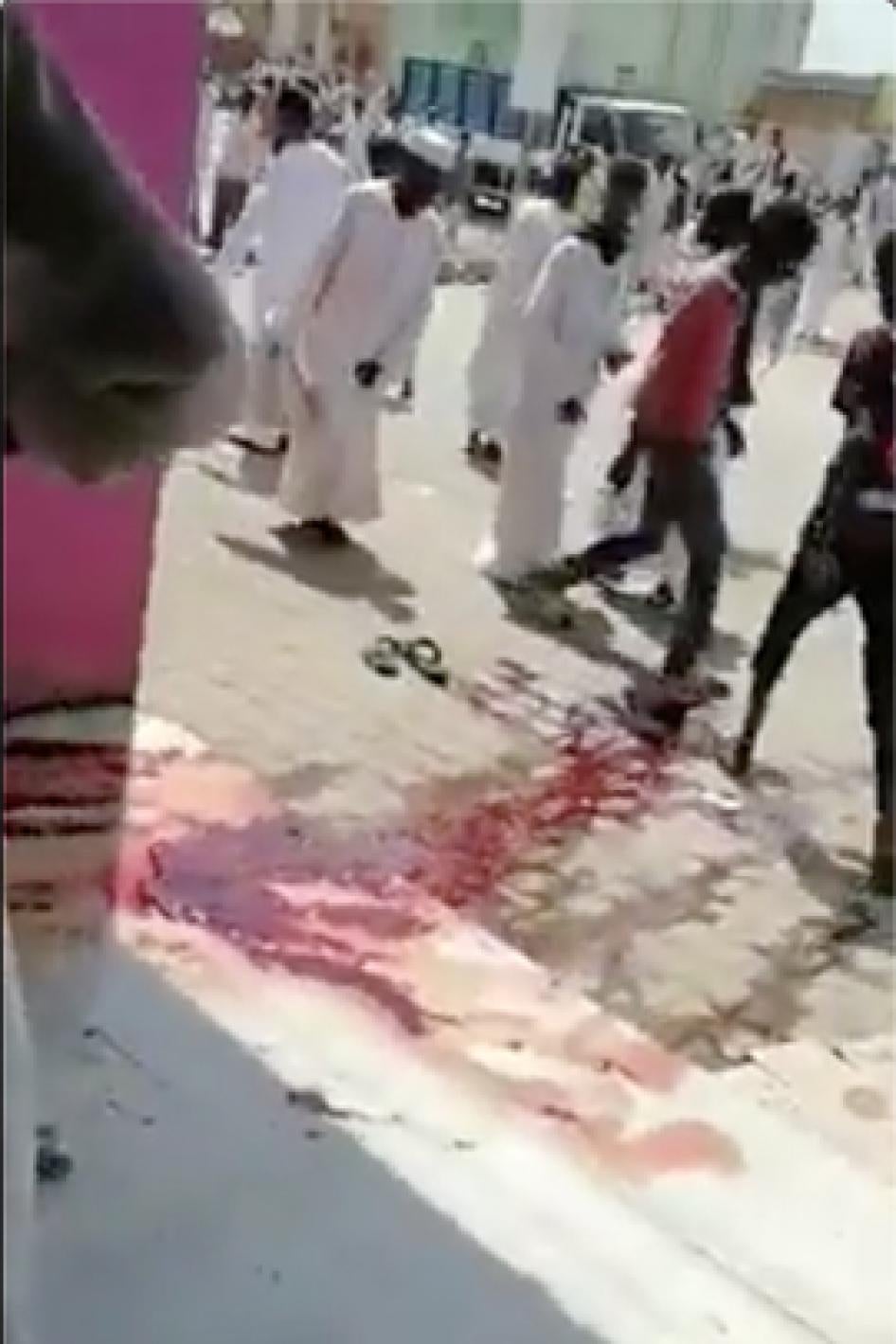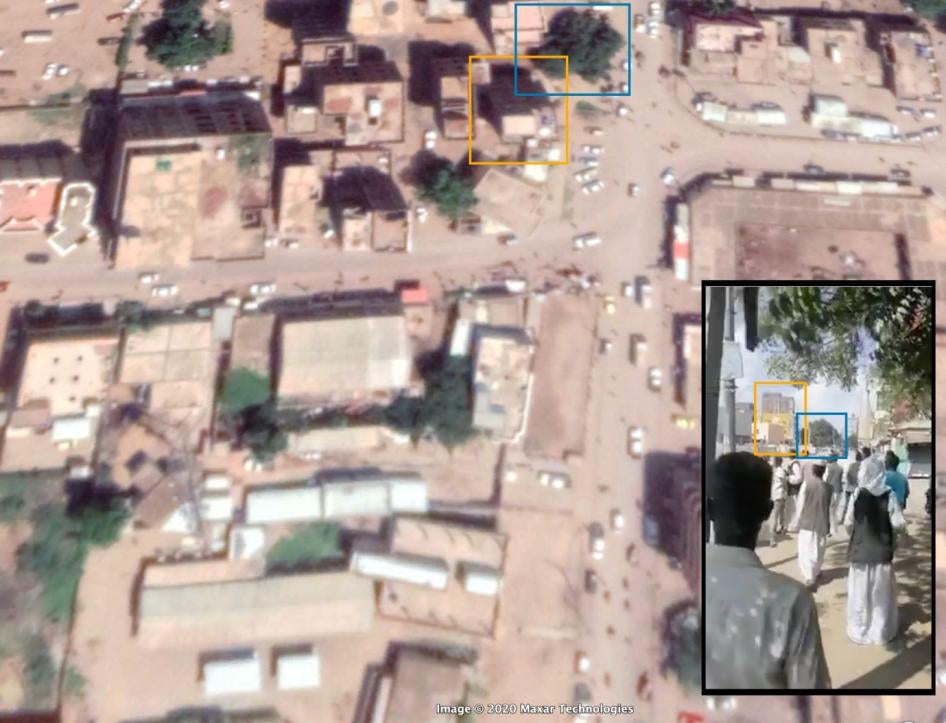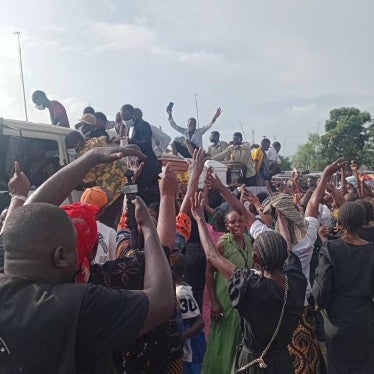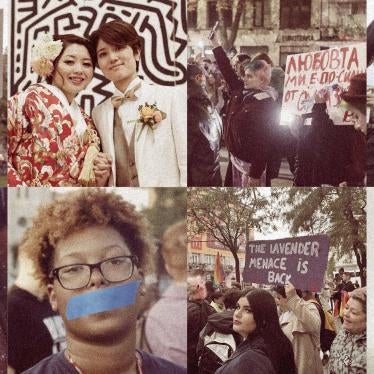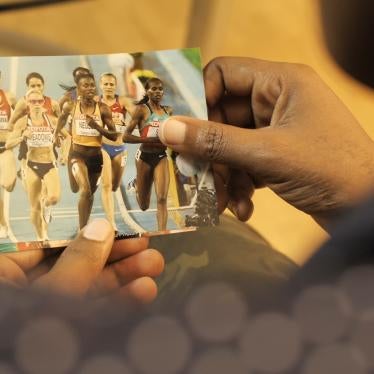(Nairobi) – Sudanese authorities used excessive force, including lethal force, against protesters on October 15, 2020, leading to the deaths of seven protesters, including a 16-year old boy, as well as a security official, Human Rights Watch said today. About 25 people were injured, most from bullet wounds.
The protests took place in the town of Kassala two days after the prime minister, Abdallah Hamdok, dismissed the governor of Kassala state, Saleh Amar. This followed weeks of unrest between members of Amar’s Beni Amar tribe and members of the Hadandawa tribe, who opposed his appointment.
“Sudan’s transitional authorities should make clear that security forces are not above the law by promptly and strictly holding to account all those who violate it,” said Ida Sawyer, deputy Africa director at Human Rights Watch. “The people of Sudan should be able to exercise their right to peaceful protest without fearing for their lives.”
Human Rights Watch interviewed 11 witnesses, including doctors, about the events in Kassala by phone and reviewed video footage, photographs, and forensic reports.
On October 15, protesters gathered in Kassala’s main square to hear speeches, and around mid-morning, some protesters headed toward the state government building, near the al-Gash bridge, which connects the western and eastern parts of the town. At this intersection, security forces consisting of the Central Reserve Police (CRP), the Rapid Support Forces (RSF), and the Sudan Armed Forces (SAF) tried to stop the protesters by firing live ammunition and teargas into the air. After the initial confrontation, police officers who had been stationed on a side street, fired directly at protesters killing two, including Abdalla Hussein Abubaker, 16.
A 24-year-old protester told Human Rights Watch:
I could see security forces stationed ahead of us, near the entrance of al-Gash bridge and state government building , almost 500-700 meters away. There we started hearing gunshots followed by teargas. I saw SAF soldiers shooting in the air. Suddenly, gunshots increased, and i could hear people around me saying some protesters had been hit.
The second stand-off happened outside the hospital where wounded protestors were being treated. CRP forces fired teargas at crowds gathered outside the hospital, many of whom came to donate blood. One witness said that teargas canisters were shot into the hospital. In response, protesters erected barricades at the approach to the hospital entrance.
Shortly afterward, three RSF vehicles, one of which carried the body of a dead soldier, sought access to the hospital, but protesters refused to allow the vehicles to approach the building entrance, a journalist interviewed said. Tensions mounted. Two videos, analyzed by Human Rights Watch, show the RSF vehicles reversing to move out of a crowd of protesters. One vehicle begins to turn around while people inside the vehicle can be seen shooting in the direction of the protestors. Witnesses said five people were killed.
A journalist at the scene said:
I immediately ran to find shelter behind the walls of a pharmacy near the hospital. One protester was near me and I was holding him, urging him not to expose himself to RSF. He ran out from our shelter. Seconds later, I heard a gunshot and saw him falling down with blood covering his clothes and chest. I ran toward his body. With a few others we carried him to the hospital. There the doctors said he was dead.
Another video taken around the same period shows a large pool of blood at the entrance to the pharmacy. A second video also filmed in front of the pharmacy shows another pool of blood.
Sudan’s information minister announced later that day that the Attorney-General’s Office was opening an investigation into the events but blamed protesters for causing the killings by clashing with security forces. While some protesters insulted security officers, threw rocks, and set-up barricades outside the hospital, Human Rights Watch is not aware of any documented incident involving protesters that posed a clear threat to life of the security forces, or others the forces were protecting.
Human Rights Watch is concerned that Sudan relies too heavily on military or militarized forces for crowd control, and that those forces are either not properly trained in law enforcement tactics or fail to use them, instead using excessive and lethal force. In particular the forces fail to recognize their obligations to respect, protect, and facilitate protesters’ right to peaceful assembly and expression, as well as the limitations imposed on them under human rights law regarding the use of force.
International human rights standards only permit using force when strictly necessary to defend against imminent harm. The United Nations Basic Principles on the Use of Force and Firearms by Law Enforcement Officials provide that law enforcement officials may only use force if other means remain ineffective or have no promise of achieving the intended result, and should exercise restraint and act in proportion to the seriousness of the offense and the legitimate objective to be achieved.
Human Rights Watch wrote to the attorney-general on November 24 to share its conclusions and to ask for updates and information on steps taken by the authorities in response but has received no response at time of writing.
The attorney-general should investigate and hold accountable officers involved in the unlawful use of force, including those responsible under the chain of command, and the transitional government should embark on security sector reforms. Such reforms should include abolishing immunity provisions that shield officials from accountability, vetting members of security forces to exclude anyone implicated in abuses, and ensuring that forces understand their human rights obligations and the importance of upholding them, especially in the context of crowd control, Human Rights Watch said.
“Peaceful protesters should not have to contend with the military on the streets, but instead should be met by well-trained and accountable law enforcement,” Sawyer said. “The transitional government has said it wants to break with the abusive days of Omar Bashir, but for that to happen, they have to do much more to reform abusive security forces.”
For details of elections-related abuses, please see below.
Sudan’s eastern states of Kassala and the Red Sea have experienced increasing unrest and intercommunal violence since 2019. In July 2020, Prime Minister Hamdok appointed 18 civilian state governors, including Saleh Amar, from the Beni Amar tribe, in Kassala. Amar’s appointment was met with significant resistance from members of the Hadandawa tribe because of a longstanding tribal feud. On August 28, clashes between supporters and opponents of the governor left five people dead in Kassala. On October 13, the prime minister removed Amar from the position.
Since the transitional government came to power in August 2019, popular protests for justice and reforms have continued in many parts of the country and on a number of occasions, security forces have used lethal force against protesters. On June 30, security forces in Khartoum killed one protester in a group demanding swift reforms and accountability of security forces. Two protesters were also killed on October 21 in the capital, in protests echoing similar demands.
Security forces used for crowd control at these protests are military or militarized units with a very poor track record in crowd control and who have had impunity for past abuses. The legal mandate of the Rapid Support Forces, which has a history of abuses, designates it as a regular military force, but since 2019 it has increasingly been deployed to control crowds.
The Rapid Support Forces led a brutal crackdown on protesters’ in Khartoum on June 3, 2019 and in the days following, in various Khartoum neighborhoods and neighboring Bahri and Omdurman, which left at least 120 people dead and hundreds injured. Human Rights Watch has also previously documented brutal attacks on civilians by the Rapid Support Forces in Darfur, Southern Kordofan, and Blue Nile. The Central Reserve Police is a militarized, combat police force that has been used in counter-insurgency operations in Darfur along with RSF and other members of the military. Human Rights Watch documented the participation of the CRP in the violent crackdown against peaceful protesters in September 2013, which resulted in more than 170 deaths.
The transitional government has established several investigation committees to examine past crimes by the security forces, but despite demands for accountability, there is no indication when they will release their findings. Victims of the violent dispersal of a sit-in on June 3, 2019 in Khartoum, and their families, have expressed frustration with the slow pace and perceived lack of transparency and independence of the committee investigating those abuses. Human Rights Watch has previously raised concerns over its lack of expertise in sexual and gender-based violence in addition to the absence of an adequate witness protection program.
Excessive Use of Lethal Force in Kassala
State Government Building
Between 8 a.m. and approximately 11 a.m. on October 15, protesters in Kassala gathered at al-Jumhoriya square in the town center to listen to speeches. When the speeches were over, groups of protesters – on foot, motorbikes, and some in vehicles – moved toward the al-Gash bridge en route to the state government building. Security forces, including Central Reserve Police (CRP), and the Sudan Armed Forces (SAF) were stationed near the intersection between the bridge and the state government building. As the protesters reached the intersection between 11:30 a.m. and noon, security forces began to fire into the air.
A protester at the front of the protest described what he saw when protesters were a few meters away from three military vehicles blocking the entrance to the state government building:
SAF stopped the protesters and asked them to move away. The protesters did not move so some soldiers started shooting in the air. One soldier fired his gun on the ground, close to where we were standing. A ricochet bullet injured a protester. A SAF captain checked on his injury, said it was light. Protesters were angered about this and asked the captain to surrender the soldier and take him to the police station. The officer promised to hold the soldier accountable but refused to surrender him to the protesters or to allow him to be taken the police station.
Then a few protesters started throwing stones before a physical altercation started with some of the protesters and soldiers. SAF soldiers here started to heavily shoot in the air again to disperse the crowd. I moved away from the scene. I then saw three CRP vehicles parked on the side of the nearby street and they were also shooting. I could see some of the soldiers shooting directly at the protesters who were running away.
Another protester further away said:
I could see that SAF and CRP soldiers were shooting in the air. Some of the CRP soldiers had teargas guns and were shooting them at the protesters. As the crowd came closer to security forces, gunshots increased. I hid behind a water tank nearby and from my location I saw CRP soldiers nearby shooting but this time directly at protesters. When I was running a bit far from the shooting, I saw a child being hit and collapse to the ground.
The child, later identified as 16-year-old Abdalla Hussein Abubakr, died. Human Rights Watch has read his autopsy report, which says his death was caused by a bullet that entered the back of his head.
A 24-year-old protester said that security forces restricted access to medical care for the wounded:
An ambulance tried to get through, but CRP [officials] started shooting again in the air and used teargas at the crowd and in close proximity to the ambulance which then scared the ambulance driver… it took them [medics] around 20 minutes to reach wounded protesters.
Another protester said security forces stopped him from helping a wounded protester:
I saw a protester who had been shot by CRP officials and collapsed on the ground, he was bleeding. I moved with other protesters to try and help him. A traffic police officer was near us and asked us to leave the area immediately. At that time, CRP soldiers started shooting around the area where we were at, so we withdrew into hiding. The wounded protester was on the ground three or four meters from where the CRP soldiers were stationed. They did not offer any help. After [about] 15 minutes, we managed to reach the protester and put him in a car. He was shot in his head, but he was still breathing. He later died in the hospital.
Violence at Kassala Teaching Hospital
Witnesses said that crowds started to gather at the hospital around noon, either accompanying wounded protesters or responding to calls on social media to donate blood. A witness said that after approximately 40 to 50 minutes, CRP officers at a distance started to fire teargas at the crowds. A witness said some of the canisters landed inside the hospital affecting doctors treating injured persons. A doctor working in the emergency room said: “We started smelling the ]tear[ gas. It was a mess, and the other doctors, medical volunteers and patients, started to find something to cover our noses and faces. It affected our ability to work and treat the wounded.”
A 37-year-old activist said he saw people begin to erect roadblocks on the approach to the hospital. At round 1 p.m. three witnesses said, three RSF military vehicles approached the roadblocks. A local journalist who had been interviewing wounded protesters said that he attempted to defuse escalating tensions between protesters and the RSF officers, who instructed protesters to move away and remove the roadblocks:
I approached an RSF officer and recognized his rank to be a major. I identified myself to him as a journalist and told him that it is better if they leave the area to avoid further escalation. The officer said they were carrying a body of a dead RSF soldier and wanted to be allowed to access the hospital. I suggested that he take the body to the military hospital. He asked me to tell the protesters not to throw stones at them. He then said they were leaving. The vehicle started to reverse. I moved few steps and turned to address the protesters. Before I opened my mouth, the RSF started shooting.
A witness said: “I saw three people get shot. I saw an old man shot in the back and fall to the ground.” Another witness added:
The old man was asking protesters not to throw stones at the RSF as they were leaving. He had his back to the RSF and was talking to the protesters. The next thing, shots were fired. I saw him on the ground. Some of the protesters joined me to reach his body to move it inside the hospital. He was already dead.
A forensic report indicates that the man, 60-year-old Ali Ismael Osman Mohamed, had injuries to the upper left part of the chest.
Human Rights Watch obtained and verified four videos from this incident. Two show the three RSF vehicles near the hospital with protesters gathering near the vehicles. The videos, filmed from different angles a few meters apart, show a crowd of protesters shouting at the RSF, the RSF vehicles reversing, and then suddenly gunshot sounds. Three military pick-up trucks, each with a heavy machine gun mounted on the back can be seen reversing down the street outside the hospital. The last pick-up truck in this convoy stops to allow four military personnel to get into the vehicle, each carrying a Kalashnikov-type assault rifle.
During this time, protesters can be seen approaching the vehicle. The truck then reverses and turns around outside the hospital. On the final turn, the truck can be seen and heard speeding off to the north, away from the protesters. As it does, a number of shots can be heard that are consistent with the sound of a heavy machine gun, followed by bursts from a Kalashnikov-type assault rifle. The shooting takes place off-camera a as the vehicle speeds off and the videographers run for cover. In one video, following this shooting, a deceased or severely injured person can be seen being carried by protesters in the direction of the hospital.
Human Rights Watch obtained multiple video footage showing the RSF vehicles near the hospital with protesters gathering near the vehicles.
An activist saw 26-year-old Isam Ibrahim, a protester he knew, being shot in the head: “I saw him hit and falling down… I tried to save him with other people around me. He was already dead.” The autopsy report shows that Ibrahim was shot on the left side of his head.
A doctor said that five people were killed outside the hospital, four of them dead on arrival and one who died later from his injuries. The doctor said:
Most of the injuries were in the chest and abdomen. There was also one injury to the head skin, one injury destroyed the jaw, one injury caused by a bullet that penetrated the skull and got stuck there. All were caused by bullets. We also treated a woman who was shot in the leg... She told us she was at her home and a stray bullet went all the way through her house’s wall and penetrate her leg.
A video circulated on social media and reviewed by Human Rights Watch shows the director of Kassala state police addressing protesters on the evening of October 15 saying: “We, all the heads of security and military bodies, were in the operation room. We did not issue any orders to use ammunition… Any bullet shot is the responsibility of the person who shot it.”
